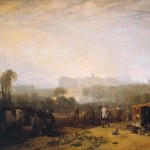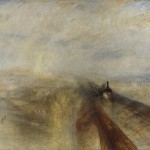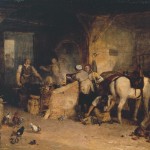J M W Turner : ‘Ploughing up Turnips near Slough’ : exh 1809 : Tate Britain.
The recent film ‘Mr Turner’ gave an intriguing glimpse into the complex nature and life of J M W Turner – an artist whose work is far more than the usual illustrated works such as ‘Rain, Steam, and Speed – the Great Western Railway’ or ‘The Fighting Temeraire’. On the surface the painting titled ‘Ploughing up Turnips near Slough’ seems worlds away from those other paintings – more like a comfortable, money spinning, essay in a seventeenth century Dutch style aimed at a then current popular market for such subjects. In one respect that is correct – Turner was a shrewd business man. In another respect it does conform to a strand in seventeenth century Dutch painting – a moralising tale. This painting is in the Tate Britain collection and the catalogue contains a really good explanatory comment :- “Windsor Castle and Eton College (to the right) rise across the Thames Valley, although Turner only mentioned Slough in his original title. Given the conditions of national self-sufficiency imposed by the Napoleonic Wars, the painting has been seen as a celebration of progressive agriculture in an Arcadian English setting, beneath the benign gaze of ‘Farmer’ George III. Details such as the nursing mother, the overseer with his back to us, the men attending to a broken plough and the woman bent double to grub up the turnip roots suggest a more difficult reality, and Turner’s sympathy for the participants.” Looked at in this light we see that the painting is alongside such works as ‘Rain Steam and Speed’, in the National Gallery London collection, in being concerned with contemporary reality – a sort of social realism. This also is representative of the importance of iron – this time the creation of Brunel’s Great Western Railway.
J M W Turner : ‘Rain, Steam, & Speed – the Great Western Railway’ : c1843 : Nat Gal London.
Another work of Turner’s, again in the Tate Britain collection, reveals the same concern for social reality as the previous two paintings – ‘A Country Blacksmith Disputing upon the Price of Iron, and the Price Charged to the Butcher for Shoeing his Pony’.
J M W Turner : ‘A Country Blacksmith Disputing upon the Price of Iron, and the Price Charged to the Butcher for Shoeing his Pony’ : exh 1807 : Tate Britain.
This reminds us that iron was still vitally important to the rural, agricultural economy and reflects the difficulties referred to in the ploughing painting caused by the ‘austerity’ of the period. The contemporary economy was still reliant upon an agricultural and rural life – but things were hard for both the blacksmith and the butcher. The connecting link between the butcher painting and ‘Rain, Steam, and Speed’ is the essential necessity for iron and the increasing demand upon that material in a changing world.
David Addison. 25th may 2015.



